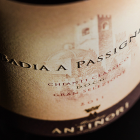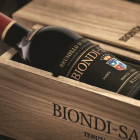Italian wine has seen a lot of love lately. Last week, the country was crowned the best destination in the world for wine lovers, and earlier this month the hills of Congegliano and Valdobbiadene – home to the country’s renowned Prosecco – were added to the UNESCO World Heritage List.
Meanwhile, Italy’s standing as a wine-producing powerhouse continues to flourish. More than 400 types of grapes are grown across 20 winemaking regions, helping Italy take the global top spot in terms of the amount of wine produced, and putting it second only to Spain when it comes to exports.
Let’s take a look at the multi-millennia-old history that’s shaped Italy’s formidable wine reputation into what it is today.
Ancient roots
Wine had long been a part of Italian culture when the Greeks first arrived in Italy in the 8th century BC, but they bought with them a true art of winemaking, and the techniques to help it flourish. The Mycenaean Greeks have been attributed to this initial endeavour, introducing viticulture first to Sicily and southern Italy. So impressed were they by Italy’s mild climate that they called the country Oenotria, or ‘the land of trained vines’.
Later, following the Roman defeat of the Carthaginians, large-scale, slave-run plantations began appearing in coastal areas, complementing the winemaking work the Etruscans were already doing in central Italy. Wine had become such a central part of everyday life – and demand for it had so increased – that in AD 92 Emperor Domitian was forced to destroy a large number of vineyards in order to free up land for food production.
Roman wine was much stronger than the Italian wine we know today, and due to its high alcohol content was usually diluted with water. The Romans preferred sweet wines and favoured white, and would often add unusual flavours such as honey, herbs, salt and even chalk in a bid to modify its taste.
While it might yet take several centuries for winemakers to refine their flavours, the Romans during this period can be credited for many contributions to contemporary winemaking. They used props and trellises, for example, and Greek presses for extracting juice. They discovered that aged wines tasted better and were the first to store it in wooden barrels. They also forged the foundations of generally-accepted winemaking wisdom, taking the time to classify their grapes and learn more about climate and terroir.
Curiously, viticulture outside of Italy was prohibited under Roman law during this time, and exports to other areas were made in exchange for slaves. Once these laws were relaxed, vineyards began to flourish throughout the rest of Europe, although Italy remained a vital import centre for wines and vines.
Adversity and triumph
The popularity of Italian wine rose and fell with the Roman Empire, although it was still consistently produced, largely by Christian monks during the Dark Ages. Come the Renaissance, however, its popularity once again skyrocketed – until the nineteenth century when, along with much of northern Europe, Italy’s vineyards fell afoul of the vine louse phylloxera.
A great number of prestigious vineyards were destroyed, and their replacements were planted with quantity rather than quality in mind. As such, the early- to mid-20th century saw Italy become a global source of inexpensive table wine. The 1960s saw officials finally take action to restore the country’s once-grand winemaking reputation, and introduced a series of laws to control quality and labelling.
The first Italian system of classification of wines was launched in 1963, and Italy’s modern wine landscape was born. Several modifications and additions have been made to the legislation since its inception, but the system now includes four basic categories, ranging from Vini (so-called ‘generic wines’) to Vini DOP (wines with protected designation of Origin). Within the DOP category exists a number of further sub-categories, each with stringent rules and regulations that are commonly taken to denote status and quality.
That said, however, looser rules for ‘lower’ categories do not always indicate lower quality. Talented winemakers will sometimes create wines using varietals or varietal percentages that do not match DOC or DOCG requirements. ‘Super Tuscans’ are a good example, and while renowned labels such as Sassicaia, Tignanello, Masseto and Ornellaia may not meet the rigid requirements of some classification levels, there is no doubt they are some of the most sought-after wines in the world – with price tags to match!
Today, Italy is known for noble reds such as Chianti, Barbaresco and Brunello, as well as zesty whites and, of course, ever-popular sparkling wines such as Asti and Prosecco. The country’s vast range of wines encompasses a flavour profile to suit every taste – and every match is one born of quality and passion. It’s not hard to see why Italian wines continue to take the world by storm.






